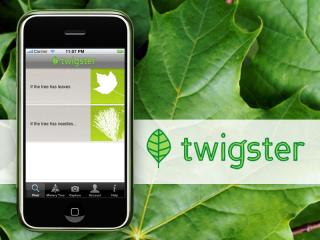Rodrigo De Benito
Zannah Marsh
Twigster
Twigster is an iPhone app designed to help urban users discover and explore the often-overlooked natural world in the city, and connect with others doing the same.
http://xtr.lobula.com/twigster/

Classes
Little Computers,Persuasive Technologies: Designing the Human
Little Computers,Persuasive Technologies: Designing the Human
While moving about the city as usual, Twigster users are on the look-out for trees on the street and in parks. They use Twigster's interactive, step-by-step visual key to identify an unfamiliar tree. The key calls out certain features-- leaf shape, twig arrangement, etc-- in helping users make an identification. The result, along with GPS data marking the tree's location, can be sent from the iPhone to the user's personal Twigster account, and to a collective interactive map. Users may choose to add a photo or notes about the tree they've found.
Some users may chose to interact with Twigster like a game, trying to identify the most trees, or seeking out the rarest, most unusual, or farthest flung trees in the city. Since identification can be tricky, users can mark a tree as a "mystery tree," add it to the map, and ask other Twigster users for help in identifying that tree. Some users may be interested in monitoring the health of particular local trees, tracking seasonal changes in foliage, or observing bird and animal life associated with the trees, and sharing this information with other users: they can add tags and notes to the map for all users to see.
Twigster's streamlined, online social networking component makes sharing information, experiences, and stories with other users easy and satisfying. Twigster aims to create a community of users fully engaged in exploring, understanding, and sharing nature with each other.
Audience
Twigster is appropriate for anyone who loves nature, is curious about science, and likes to collect and explore. Twigster users may be school children, senior citizens, or anyone in between.
Some users may chose to interact with Twigster like a game, trying to identify the most trees, or seeking out the rarest, most unusual, or farthest flung trees in the city. Since identification can be tricky, users can mark a tree as a "mystery tree," add it to the map, and ask other Twigster users for help in identifying that tree. Some users may be interested in monitoring the health of particular local trees, tracking seasonal changes in foliage, or observing bird and animal life associated with the trees, and sharing this information with other users: they can add tags and notes to the map for all users to see.
Twigster's streamlined, online social networking component makes sharing information, experiences, and stories with other users easy and satisfying. Twigster aims to create a community of users fully engaged in exploring, understanding, and sharing nature with each other.
Audience
Twigster is appropriate for anyone who loves nature, is curious about science, and likes to collect and explore. Twigster users may be school children, senior citizens, or anyone in between.

